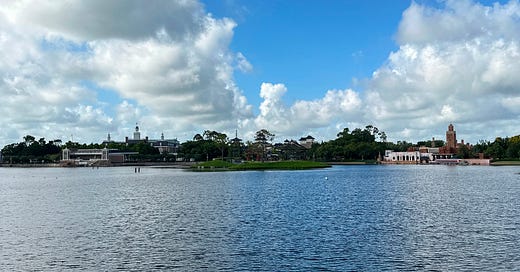Call me a hypocrite.
But as the age of TikTok, YouTube, and 24/7 live streaming accelerates, a silent threat is growing — not from budget cuts or corporate restructuring, but from within the parks themselves.
This threat isn't just bad press or a viral moment gone wrong. It's systemic, cultural, and increasingly corrosive. We're talking about the live streaming problem — the culture of everyday guests broadcasting full-day, unmoderated, monetized content from inside the parks, often involving Disney Cast Members in parasocial relationships they never signed up for. And while some may argue that streaming helps with exposure and builds hype, the truth is murkier: it's creating an oversaturated, toxic, and unpredictable environment that may be eroding the guest experience more than Disney realizes.
Proactive vs. Reactive
The core problem is Disney World’s reactive posture. Time and again, the Walt Disney Company has adopted a “wait-and-see” approach to guest behavior that results in patchy, delayed, and inconsistent policy updates — if any at all.
Case in point: stroller restrictions, e-cigarette bans, and selfie stick policies all came after widespread problems forced the company’s hand and all are loosely enforced for various reasons. When it comes to live streaming — which often involves unwitting cast member appearances, privacy invasions, and park traffic disruption — Disney World seems once again to be waiting for the problem before doing something about it. By the time they act, the damage may be embedded into the culture.
Compare this to Tokyo Disney Resort, where proactive cultural and operational policies have prevented this very issue. Tripods are discouraged. Guests in Japan culturally understand that the experience is shared and that others’ enjoyment should not be disrupted by someone else’s personal brand-building. Cast Members are treated with reverence — not recruited into fan parasocial fantasies. That isn’t just cultural; it’s by design.
Why Disney Doesn’t Need This Kind of “Hype”
There’s a pervasive myth — pushed mostly by creators themselves — that Disney “needs” this kind of coverage. Disney is not a local theme park trying to get on the map. It is arguably the most recognizable brand in the world, with a marketing budget that dwarfs entire entertainment companies.
The idea that Disney World relies on creators for exposure is delusional. Worse, it puts the company in a bind: How do you control your own narrative when someone else is profiting off a version of your experience — unscripted, uncontrolled, and potentially brand-damaging?
Some streamers know this and behave responsibly. MOST do not. Some push boundaries intentionally to gain notoriety. This isn’t just irresponsible; it’s a liability.
Exposure is not inherently valuable when it becomes uncurated noise. And Disney is suffering from oversaturation. The endless litany of livestreams doesn’t build magic. It dulls it. It turns the parks into a backdrop for someone else’s content strategy. And it makes it harder for first-time guests to have a truly fresh, unspoiled experience. Not to mention the toll on cast members.
I know this because this has become my actual profession, not just a hobby for clout before or after work.
In this sense, live streaming isn’t just a privacy risk. It’s a workplace hazard.
Tokyo Disney: A Blueprint for Balance
Tokyo Disney isn’t perfect, but it offers a compelling alternative. Filming is allowed in certain contexts, but not in a way that disturbs the experience of others. Most importantly, the guest culture — reinforced by park leadership — sets expectations early and often.
It’s not just about rules. It’s about values. That is the culture there. Self awareness and consideration for others.
In Tokyo, the emphasis is on shared experience, not individual spotlight. That doesn’t mean there are no influencers or vloggers.
Disney World needs to learn from that. Because waiting for a crisis — a lawsuit, a viral meltdown, or worse — will only erode trust further.
What Needs to Happen — Now
A hard ban on all streaming.
Many people attribute my live streams as the trend setter for TikTok Disney Park Lives. It was not a trend when I started but an escape that somehow evolved beyond my expectations.
Just as I may have kicked off this trend I’m very happy to begin the trend of ending it.
-Published from Epcot






Here is what I see happening. I do think a ban for live streaming is coming. But it’s not coming to protect the user experience. That is not what this Disney is about. What they are about are the all important earnings report and stock price. Nothing else matters. So I see cast members as the new streamers. Disney parks items sold in tik tok shop. Streaming exclusive merch! Gifting revenue. They monetize, they control the narrative. The guest experience still suffers but they are making money so who cares right. Cheap advertising. Exploit the FOMO!
Agreed. Very well stated. I hope Disney takes this seriously and nips it in the bud before it’s too late. Or is it already too late? It’s teetering on the bubble that is bound to pop at any moment and liability will probably be the reason if a ban takes place. It’s reckless on their behalf to not take heed in this warning.